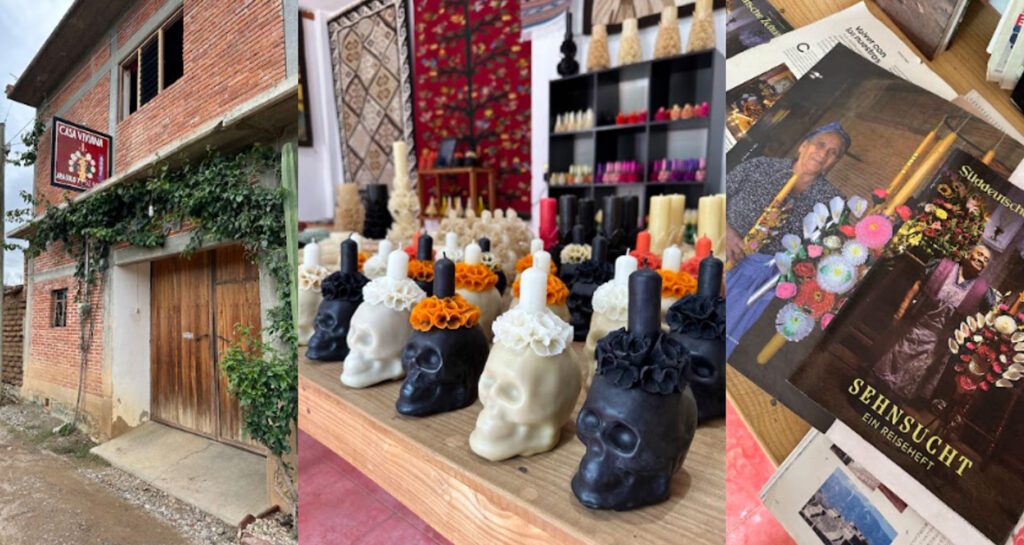On my last trip to Oaxaca, I was on a mission—not a rigid, guidebook-clutching, Excel-itinerary kind of mission—but a wanderer’s mission. The kind where you trust that if you stay curious and present, the magic will find you. And oh, did it ever.
Oaxaca, for the uninitiated, is a feast. A living, breathing canvas of color, spice, music, and heart. I was traveling solo—something I do often and love—but even a seasoned solo female traveler like myself likes to keep things safe when venturing into more remote areas. Enter Eddy: my friend Kimmy’s trusted taxi driver and now my unofficial Oaxaca road trip buddy.
I told Eddy I wanted to visit Teotitlán del Valle to see some traditional candle makers. Full disclosure: I hadn’t done any research (which, honestly, is part of my charm). I like to find the story as I go, old-school journalist style. Luckily, Eddy is more of a spreadsheet guy and somehow found what I soon learned was the most famous Zapotec candle maker in the world.
We pulled up unannounced to a modest house with no signs or frills. Just a simple door in a quiet village. We knocked, and out came a small Zapotec woman with wise eyes and a no-nonsense energy. This was Doña Viviana Alávez, internationally renown candle artisan, cultural gatekeeper, and—as I would soon discover—had an incredibly inspiring story.
We asked, a bit sheepishly, if we could see her candles. She didn’t hesitate. She led us into her humble shop—really just a room in her home where the candles lived, resting quietly like sacred relics. The air was thick with the smell of beeswax and stories.
There were small, medium, and larger candles, ranging from $20 to $100 USD. Works of art, every one of them. On a dusty corner table lay a copy of Vogue, where she had been featured for preserving the centuries-old candle-making tradition of her ancestors.
Naturally, I asked if she’d tell us more. “Yes,” she said, “but I must keep working.” And off she went—to the back, to her candle-making altar—kneeling on her heels (a position she keeps for 8 to 10 hours a day) and motioning for us to sit down while she worked and spoke.
The Flame of a People
Doña Viviana began making candles when she was 10 years old. She’s now 75, and she is the pioneer of a delicate flower-making technique that transformed candle decoration across the region. The candles she makes aren’t simply ornamental. Candle making in Teotitlan is a Zapotec tradition, and candles are not just sources of light—they are carriers of prayers, symbols of commitment, and offerings to the divine. In a traditional Zapotec marriage, candles are often part of the “pedida de mano” (asking for the hand) ceremony. The groom’s family presents towering candles—beautifully adorned with wax flowers, birds and religious symbols and made by hand—as symbolic gifts to the bride’s family, representing purity, respect, and the illumination of their future together. This is a village where people live on humble means, and a large human-sized candle with many handcrafted flowers all made by hand takes Doña Viviana about one month to make, working 8-10 hours a day and costs between $1000-$2000 US dollars. The groom has to prove his worth, especially to the father of the bride. Then that candle is burned on the wedding night and the days afterwards.
Doña Viviana sources natural beeswax from Oaxaca and Chiapas, which carries a rich golden hue. She purifies it herself, melts it over fire in large pots, and adds natural dyes used for generations in Zapotec textiles such as:
- 🌺 Cochineal for vibrant reds and pinks (symbolizing love and sacred blood),
- 🌿 Indigo for deep blues (protection and spiritual connection),
- 🌼 Marigold and local herbs for golden tones.
Then begins the most mesmerizing part: the goteo
Wax, Patience, and Rooftop Rituals
A wick is suspended from a ceiling beam. Wax is poured—drop by careful drop—over the wick. Layer by layer. Day by day. Week by week. It’s not just a craft. It’s a meditation on time, intention, and devotion.
When the candle finally takes shape, it’s taken up to the azotea, or rooftop, where the sun and mountain air do the rest. There, surrounded by birdsong and cactus silhouettes, the wax hardens. But even this part is delicate. If the sun is too strong, the wax will crack. If it’s too humid, it won’t cure properly.
Walking onto her rooftop felt like stepping into a hidden world—a living workshop between earth and sky, where slow art still exists and still matters.
Creating the Intricate Details
Doña Viviana spends most of her days kneeling and sitting on her ankles sculpting tiny ornaments—roses, flowers and symbols—all made of wax. Her hands, which have shaped thousands of petals, move with a precision that only comes from decades of love and repetition.
And then comes the final act: she locks herself in a room, ordering her family not to interrupt her as she assembles the candle, piece by sacred piece, until it becomes something so extraordinary that is a monument larger than herself
Her work has now been commissioned by art collectors in NYC, London, and beyond. But make no mistake: it’s still just her, kneeling on her heels in that quiet room, doing the work the way she’s always done it.
A Quiet Legacy
There were no tourists in Teotitlán that day. No crowds, no curated Instagram moments. Just us, and her, and the sound of beeswax cooling in the sun.
It was an honor to sit with Doña Viviana, to witness her craft, and to be reminded that art, discipline, and tradition don’t need to shout to be powerful.
They just need someone willing to listen.
So if you ever find yourself wandering the valleys of Oaxaca—ask for the candle lady in Teotitlán. Bring curiosity, humility, and time. Lots of time.
Because some things are too sacred to rush.




